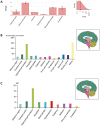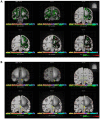Neuropilin‑1 as a new potential SARS‑CoV‑2 infection mediator implicated in the neurologic features and central nervous system involvement of COVID‑19
- PMID: 33000221
- PMCID: PMC7533503
- DOI: 10.3892/mmr.2020.11510
Neuropilin‑1 as a new potential SARS‑CoV‑2 infection mediator implicated in the neurologic features and central nervous system involvement of COVID‑19
Abstract
Infection by the severe acute respiratory syndrome (SARS) coronavirus‑2 (SARS‑CoV‑2) is the cause of the new viral infectious disease (coronavirus disease 2019; COVID‑19). Emerging evidence indicates that COVID‑19 may be associated with a wide spectrum of neurological symptoms and complications with central nervous system (CNS) involvement. It is now well‑established that entry of SARS‑CoV‑2 into host cells is facilitated by its spike proteins mainly through binding to the angiotensin‑converting enzyme 2 (ACE‑2). Preclinical studies have suggested that neuropilin‑1 (NRP1), which is a transmembrane receptor that lacks a cytosolic protein kinase domain and exhibits high expression in the respiratory and olfactory epithelium, may also be implicated in COVID‑19 by enhancing the entry of SARS‑CoV‑2 into the brain through the olfactory epithelium. In the present study, we expand on these findings and demonstrate that the NRP1 is also expressed in the CNS, including olfactory‑related regions such as the olfactory tubercles and paraolfactory gyri. This furthers supports the potential role of NRP1 as an additional SARS‑CoV‑2 infection mediator implicated in the neurologic manifestations of COVID‑19. Accordingly, the neurotropism of SARS‑CoV‑2 via NRP1‑expressing cells in the CNS merits further investigation.
Figures



References
-
- World Health Organisation (WHO), corp-author Coronavirus disease 2019 (COVID-19): Weekly Epidemiological Update. 21 August 2020. www.who.int/emergencies/diseases/novel-coronavirus-2019/situation-reports. Last accessed August 22, 2020.
-
- Gavriatopoulou M, Korompoki E, Fotiou D, Ntanasis- Stathopoulos I, Psaltopoulou T, Kastritis E, Terpos E, Dimopoulos MA. Organ-specific manifestations of COVID-19 infection. https://doi.org/10.1007/s10238-020-00648-x. Clin Exp Med. - PMC - PubMed
MeSH terms
Substances
LinkOut - more resources
Full Text Sources
Molecular Biology Databases
Miscellaneous

